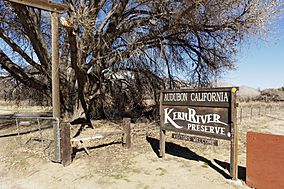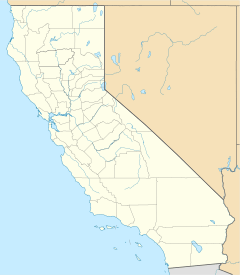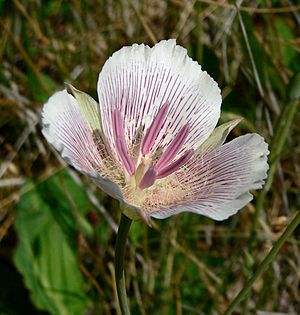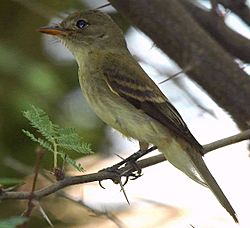Kern River Preserve facts for kids
Quick facts for kids Audubon Kern River Preserve |
|
|---|---|

Entrance from SR 178
|
|
| Location | Weldon, California, State Route 178 northeastern Kern County |
| Nearest city | Bakersfield, California |
| Area | 2,987 acres (12.09 km2) |
| Established | 1979 |
| Governing body | National Audubon Society |
The Audubon Kern River Preserve is a special nature area in California, United States. It is owned by the National Audubon Society, a group that works to protect birds and their homes. This preserve is located near Weldon in Kern County.
The preserve protects one of the biggest natural forests along a river left in California. This area, about 3,000 acres (12 km2) in size, is a safe home for many rare and endangered birds. One important bird here is the southwestern willow flycatcher, which is a federally endangered species. The preserve is also part of a "Globally Important Bird Area." This means it's a super important spot for birds all over the world.
The South Fork Kern River flows through the preserve. This river is special because it was named a national "Wild and Scenic River" in 1987. The river provides water for farming and for the unique forests in the valley. In the higher parts of the river, you can find golden trout, which is California's state fish. Scientists are watching these trout closely because they might become endangered.
Scientists also come to the Kern River Preserve to study nature. For example, the Grinnell Resurvey Project looked at how animals have changed over time. The preserve also has a visitor's center, a nature trail, and fun events. You can even volunteer to help out!
Contents
History of the Preserve
The Audubon Kern River Preserve is located on what used to be a large cattle ranch. This ranch belonged to a man named Andrew Brown and started way back in the 1860s.
Andrew Brown's Ranch
Andrew Brown was born in Ireland in 1829. He came to California in 1852 and later settled in Kern County. He owned a general store and bought a ranch. Brown raised cattle, sheep, hogs, and grew wheat. He also built a flour mill and a sawmill. His businesses did well, so he bought more land. In 1901, he created the A. Brown Company. The Brown family kept running the ranch until the 1970s.
After the Brown family sold the ranch, there was a chance the land could be developed. But a group called The Nature Conservancy quickly stepped in. In 1979, they bought 1,600 acres (6.5 km2) of the ranch. They got money from groups like Getty Oil Company and the W. M. Keck Foundation to do this.
Growing the Preserve
The Nature Conservancy continued to add more land to the preserve. They traded some of their pasture land for forest land with nearby ranches. This helped the preserve connect to other protected areas. In 1981, a fence was built to protect the trees and plants along the river from grazing cattle.
In 2005, the Audubon California chapter and the California Department of Fish and Game bought even more land. This was done to help make up for habitat that was lost when Lake Isabella flooded. A total of 1,640 acres (6.6 km2) was added to the preserve. More land was bought in 2006 and 2009. These new areas added more riverfront property and important nesting sites for birds.
Cattle and Conservation
The Audubon California organization also works with local ranchers to protect the land. One rancher, Bruce Hafenfeld, has a family ranch where he raises calves and cows. He made a special agreement called a "conservation easement." This agreement helps make sure his property stays a working ranch and also protects nature forever.
Hafenfeld explained that they worked to show that ranching could help nature, not hurt it. They created a plan to improve the wetland habitat on his land. This helped more wildlife come to his ranch. It took many years and a lot of teamwork to set up this special agreement.
Plants and Animals
The Kern River Preserve is home to many different kinds of plants and animals. The South Fork Kern River is the most important part of this preserve.
South Fork Kern River and Valley
The South Fork Kern River starts high up in the mountains at 10,400 feet (3,200 m). It flows down through the preserve to Lake Isabella. The South Fork Valley is only a few miles wide and about 15 miles (24 km) long. It's located at the southern end of the Sierra Nevada Mountains.
Even though this valley was one of the first places settled in the county, it still has the largest natural forest along a river in California. This forest is called the Great Valley Cottonwood Forest. It has many Fremont cottonwood and willow trees. The ground beneath these trees is thick with wild roses and Oregon ash. The river's yearly floods keep the soil rich and healthy.
Scientists say that this type of forest used to be common along rivers. But now, most of it is gone because of dams, water use, farming, and cities. The Kern River Preserve helps protect what's left.
One rare wildflower found here is the alkali mariposa lily. This beautiful flower blooms in April and May. It is considered rare and is threatened by grazing animals, roads, and people collecting them.
Bird Species
The trees and plants along the river provide perfect nesting spots for many birds. These include the federally threatened western yellow-billed cuckoo and the endangered southwestern willow flycatcher. Other birds like the brown-crested flycatcher, yellow warbler, and yellow-breasted chat also live here.
The southwestern willow flycatcher is an endangered bird that lives in the preserve. Audubon staff and volunteers watch these birds very closely. The US Fish and Wildlife Service has marked parts of the South Fork Kern River as "critical habitat" for this bird. This means these areas are super important for the flycatcher's survival.
Another interesting bird is the summer tanager. This bird lives near streams and is known for eating bees and wasps. It's smart enough to rub the bee on a branch to remove its stinger before eating it!
Scientists hope that the least Bell's vireo will also start nesting here again. This bird disappeared from California's Central Valley by the 1960s. It has been endangered since 1986. The main reason for its decline is the loss of its river habitat. Another problem for this bird is the brown-headed cowbird. These cowbirds lay their eggs in other birds' nests, which is called "brood parasitism." The Southern Sierra Research Station has a program to remove cowbirds. This has greatly reduced how often cowbirds lay eggs in other birds' nests.
Mammals, Amphibians, Reptiles, and Insects
Many common mammals live at the preserve, such as mule deer, coyotes, and bobcats. You might also see dusky-footed woodrats and California ground squirrels. Less common animals include mountain lions and beavers. In total, about 50 different types of mammals live here.
The preserve also has three types of amphibians and 24 types of reptiles. These include the common garter snake, California kingsnake, and several kinds of lizards. The only venomous snake is the Northern Pacific rattlesnake. You can also find the Pacific pond turtle here. This turtle is a species of concern in California.
The South Fork Valley is special because three major plant regions of the nation meet here. This creates a huge variety of plants and animals. For example, there are 31 types of dragonfly and 53 types of butterfly! These include the alkali skipper and the rare San Emigdio blue butterfly.
Scientific Research
Many important scientific studies happen at the Kern River Preserve.
Grinnell Resurvey Project
Joseph Grinnell was a famous zoologist who started a huge survey of California's animals in 1908. He spent 30 years studying over 700 locations. His work created a massive database with thousands of animal specimens, field notes, and photos. This collection is one of the most complete of its kind in the world.
Scientists from the University of California, Berkeley, started to re-survey Grinnell's original routes. They wanted to see how animal populations and their habitats have changed over time. The Kern River Valley area was studied in 2008 and 2009. The original notes from Grinnell's surveys are available online. These new studies show that some animal territories are growing, some are shrinking, and some species are moving to higher elevations.
Other Research
Scientists are also working to help the southern Pacific pond turtle. Since 2006, they have been "headstarting" pond turtle hatchlings. This means they raise the baby turtles in captivity until they are big enough to avoid predators. Then, they release them into the wild. As of 2010, 17 young turtles had been released.
The Southern Sierra Research Station also studies the western yellow-billed cuckoo and the southwestern willow flycatcher at the preserve. Another scientist, Donald Mitchell, has studied how hummingbirds migrate through the preserve. He is allowed to band hummingbirds to track their movements.
Public Access and Education
The Audubon Kern River Preserve is open to the public from sunrise to sunset every day. It hosts four festivals each year, along with monthly nature programs and volunteer days.
- In April, there's the Kern River Valley Bioregions Festival. It has guided hikes, workshops, crafts, music, and exhibits.
- In August, the Kern Valley Hummingbird Celebration takes place. You can go on nature walks, learn to identify hummingbirds, and find out how to garden for them.
- In September, the Kern Valley Autumn Nature & Vulture Festival is held. It starts with a "Turkey Vulture Lift Off" where you can watch the birds leave their roost. The festival also has bird walks, informational booths, and live animal displays.
- Monthly Nature Exploration events happen on the first Saturday of each month. Experts lead these events, covering different outdoor topics.
- Monthly volunteer workdays are held on the third Saturday of the month. You can help with projects like restoring habitats, removing fences, or maintaining trails.




